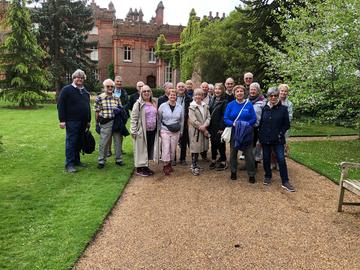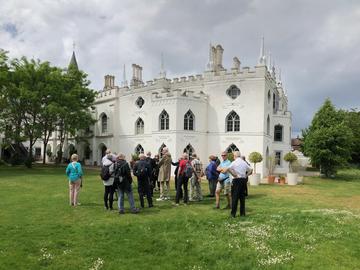A tour travelogue: Jewish country houses in the English home counties
B’nai B’rith (BB) Cheshire, a constituent lodge of BBUK, was the first group to build on the research undertaken for the Jewish Country Houses Project and participated in a four- day trip to five Country Houses and one museum in and around the western home counties in May 2022. The 21 of us were accompanied throughout by our scholar-in- residence Marcus Roberts, an Affiliated Researcher and Heritage Partner of the Jewish Country Houses project at the University of Oxford. His research, under the leadership of Professor Abigail Green, also formed the basis of his talks and evening PowerPoint presentations.
We learnt about the context behind these Jewish property acquisitions. Most successful Jewish families like the Rothschilds, arrived in England from Europe but despite being part of European aristocracy, were not allowed to have landed estates here until 1833. However, it didn’t stop them from marrying their daughters off into the English aristocracy!
Owning a landed estate was a measure of power and success. It announced one’s “arrival” into the British aristocracy and, for example, one could only become a Member of Parliament at that time if one was a member of the landed gentry. A London residence represented the ‘business’ side of life but entertaining fashionable society in a magnificent country house where pursuits such as hunting and shooting was the order of the weekend and where one’s wealth and success in society could really be shown off! A sign of good taste was to have beautifully cultivated and maintained gardens. Whilst a London abode may have been where their Jewish heritage was apparent and their involvement in Jewish life carried out, there was little evidence of a Jewish background in the country houses. These homes had to blend in with the gentry!
Our first stop was Waddesdon. We learnt that Ferdinand Rothschild (from the Austrian branch of the family) bought the Waddesdon Estate in Buckinghamshire from the Duke of Marlborough in 1874. By then he had built a hospital in Southwark; was Treasurer to the Board of Guardians of the Jewish Poor; was Warden at the Central Synagogue in Great Portland Street and had funded a technical scholarship at Stepney Jewish School in the East End. His friends included Benjamin Disraeli and Ferdinand was a member of the circle surrounding the then Prince of Wales. Ferdinand set about building a country house in the style of a Renaissance chateau and filled it with magnificent paintings and furniture. Although we didn’t have much time to enjoy them, Ferdinand planted mature trees in the landscaped grounds; built an aviary and many glasshouses that provided exotic flowers and fruit. Queen Victoria visited in 1890 - Ferdinand had arrived!
We learnt about, but unfortunately were unable to see, the “Balfour archive” the bundle of letters and correspondence that lead to the famous letter from Arthur Balfour to Walter Rothschild then considered to be the leader of UK Jewry.
We were told that the Rothschilds also housed 100 evacuee children from Croydon at Waddesdon Manor during World War Two. Whilst the British government of the day made provision for 10,000 unaccompanied children to be given refuge, what is perhaps less well known is the fact that the government issued a proviso that each child had to have a guarantor pledging £50,000. Safety didn’t come cheap!
Marcus conducted a walking tour of Waddesdon village pointing out the large house in the village called The Cedars where many of the 30 orphans rescued from Frankfurt in 1939 by the Rothschilds were housed. We had previously seen the two oak trees planted in 2022 by the Association of Jewish Refugees in the grounds of Waddesdon Manor, thanking Mr and Mrs James de Rothschild for giving sanctuary to the Holocaust refugees known as ‘The Cedar Boys’.

The second day started with Benjamin Disraeli, a very distant and much less affluent relative of the Rothschilds who bought his country home, Hughenden, at High Wycombe, with the help of money given to him by friends. Whilst Disraeli was Chancellor three times, he personally was always in debt! Aged 13, Disraeli, along with his siblings, had been baptised into the Church of England but this charismatic statesman was nevertheless very proud of his Jewish background. The Country House project had borne fruit as the guides described in detail Disraeli’s continuing interest in his Jewish background, evident amongst the books, letters, and other items in a special display. Devoted to his wife, they shared the same bedroom, wardrobe and flushing commode - the first ever seen! Queen Victoria was particularly fond of this novelist, statesman and social outsider turned aristocrat and left him several paintings on her death which can be identified by a crown on the frames.
Possibly our favourite home was the Rothschild property Ascott House, where we were shown around in a private viewing. Whilst run by The National Trust, this still remains the home of Sir Evelyn de Rothschild and his family. This beautiful Tudor property housed yet more magnificent paintings and a fine collection of Chinese porcelain. The photos on display of a recent wedding and other family simchas and gatherings were evidence of this ‘marriage’ between the continuation of the family’s Jewish heritage and the conspicuous wealth of the UK landed gentry.
The Rothschilds were great collectors and we visited the Natural History Museum in Tring to view some of the one million exhibits kept here – 300,000 having been sold off in the last century. The building was given to Walter, the second Lord Rothschild, as a 21st birthday present from his father to house his already impressive collection of natural artefacts. His niece, Miriam, followed in his footsteps and made a distinguished career as a scientist, naturalist and conservationist.
Moving on from the Rothschild family, we went to see Upton Manor the country home of Walter Samuel. His father, Marcus, began his business life trading with the Middle East and the Orient where he bought and sold everything from rice to exotic sea shells which he had made into ornamental boxes. These were very fashionable in Victorian Britain and business thrived. Later, Walter’s father and an uncle took over the business and formed The Shell Transport and Trading Company which, when merged with the Royal Dutch Petroleum Company, became known simply as Shell. Walter became the second Lord Bearsted and he made Upton House and Gardens his family’s country home in 1927. He did a lot for the local community, providing work during the Great Depression and he and his wife made regular and substantial donations to a range of charities from hospitals and children’s societies to seaman’s missions and from cancer charities to Jewish schools. Interestingly, in contrast to the Rothschild properties, the National Trust made little of the Jewish connection. We learnt that there is much material in the archives about the family’s support for Jewish philanthropic endeavours but this was not yet on display!

Our final home was the rather exotic Gothic Revival style Strawberry Hill House, in West London. This was built by the architect Horace Walpole in the 18th century. Eventually the house passed to Count and Countess George Waldegrave. Her father was Jewish and she took a keen interest in extending the original house, adding a curved drive and had a railway station built nearby to allow her friends easier access when visiting! Unlike the other country homes, this one was built close to the river Thames at Twickenham which, before the station was built, allowed guests to arrive by boat – a much safer trip from London as journeys through the countryside were very susceptible to robberies. Unfortunately, George spent most of the family fortune and a “Great Sale” lasting 24 days was held in the grounds in 1842 which resulted in the house being stripped of most of its contents. From 1883 to 1887 the property was owned by German-Jewish Baron Hermann de Stern – a British banker – but he never lived there!
Our tour was not about seeing, nor was it expected to be filled with, specific objects of Jewish interest although in some of these homes, a few paintings and other items with a Jewish theme were pointed out by guides. Rather, the tour succeeded in showing how, despite all the challenges of anti-Semitism over the centuries, there was phenomenal Jewish wealth amongst a small elite, that combined passions for art, culture and philanthropy. We are now planning our trip next year to JCH’s in Kent!
Alan Silman


